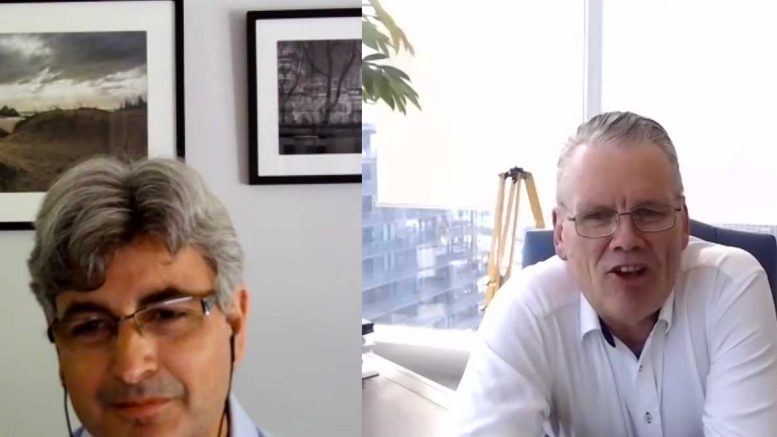As the last day of the Canadian Mining Symposium (CMS) began on June 18, it was clear that the global community had embraced the online, virtual version of the annual event. Anthony Vaccaro, group publisher of The Northern Miner and head of global mining for Glacier Resource Innovation Group, said there had been considerable feedback, comments and questions posted by attendees since the CMS began. One of the best takeaways from seeing this, he said, was realizing the international nature of this year’s CMS audience, which logged in from 51 different countries around the globe.
Vaccaro then mentioned the morning news that research and consultancy firm Wood Mackenzie was reporting on the need for the gold sector to commission 8 million ounces of gold projects if it wants to maintain 2019 production levels. According to their research that works out to about 44 projects, with the industry required to invest about US$37 billion to achieve these goals (based on a capital intensity of US$4,610 per oz. gold per year).
Beyond the staggering financial investment required, Vaccaro pointed out, the report also stated that these new projects must come online by 2025. And that expedited, five-year timeline means the mining industry must look at new ways to finance, explore and develop greenfield projects.
One approach was provided in the day’s first keynote discussion, which centred on the business of streaming precious metals. From his Vancouver office, Randy Smallwood, the president and CEO of Wheaton Precious Metals (TSX: WPM.CA; NYSE: WPM), chatted with Northern Miner senior reporter Carl Williams about a facet of the mining industry that remains obscure to many.
But first Smallwood was asked about his early days in the business.
“I was actually 22-23 years old when I got a job staking mineral claims here in British Columbia. I’d unlocked the hidden treasure hunter in me,” he said with a grin. “I still remember that first day in a camp, coming back in and realizing that I was getting paid for something I actually loved doing.”
From those early days in the bush, Smallwood went on to become an exploration geologist, joining Wheaton River in 1993. Later he was involved in the founding of Wheaton Precious Metals, becoming its president in 2010, and adding the CEO title just over a year later.
Williams then asked about the streaming model, and Smallwood distilled Wheaton’s approach to this investment strategy.
“The simplicity of the model is sometimes confusing,” he said. “Basically, we make an upfront payment, generally in cash, though sometimes it’s shares. And what that does is it give us the rights to a percentage, a fixed percentage, of whatever future precious metal production comes out of this [project].”
Smallwood pointed out that another key aspect of the arrangement is that as the metal is delivered to Wheaton, they make a delivery payment to their mining partner – on a per ounce basis – that is also fixed by the contract.
“This means that we’ve taken a lot of the cost risk out of our equation,” Smallwood told the attendees. “So when people invest into [Wheaton] as a streaming company, they know what the capital cost is, which is the upfront payment, and also know what the production cost is, which is the delivery payment.”
According to Smallwood, the streaming concept takes a lot of the risks out of the traditional investment model that’s been used for decades. He also said that Wheaton is very selective about who they invest in, looking for low-risk, high-quality assets with long resource lives.
Wheaton’s diversified portfolio includes 20 operating mines and nine development projects, the vast majority of which are in the Americas. These range from majors such as Vale (NYSE: VALE), Glencore (LSE: GLEN) and Newmont (TSX: NGT; NYSE: NEM) to juniors like Panoro Minerals (TSXV: PML) and Kutcho Copper (TSXV: KC).
But he also emphasized that another part of his company’s core values are ESG and CSR, and that management also uses these guidelines in the decision-making process when evaluating mining projects. From Wheaton’s perspective, their stakeholders include, not only the firm’s shareholders and its mining partners, but those people living near the mining projects.
“And that is our neighbours; that is our third stakeholder,” he told Williams, saying Wheaton is very observant of what sustainable benefits their partners deliver to the communities living around the mine sites.
“All of this adds to our vision, and that is to be the world’s premiere precious metals investment vehicle, the best way to invest into precious metals,” he said.
The next keynote discussion was also centred on investing in gold. It featured New York-based Joe Foster, portfolio manager and gold strategist with VanEck, and Toronto-based Dean McPherson, head of business development at TMX Group.
Foster joined VanEck in 1996, first as an analyst and then managing funds. He has had a front seat watching the rise, fall, and rise again of gold. He believes we are currently in the middle of a “secular” bull market in gold. “Secular being a long-term bull market that is driven by systemic risks to the financial system,” he explained.
He pointed out that many people didn’t realize there was a bull market going on until last year, even though gold had been climbing out of its nadir since December 2015.
“Usually the big companies – the majors – lead in terms of performance, when gold is rising,” he said. “And then the smaller companies catch up, and ultimately outperform the larger companies.”
What Foster says is different in this cycle is that we have not been seeing this traditional pattern so far. When gold broke out last year, he says, the big companies did very well, but a lot of the smaller companies were lagging for quite some time.
“It wasn’t until just the last month or two that we’ve seen the smaller companies really start to perform and start to make that catch-up. Usually that catch-up, it’s measured in weeks, maybe a month or two. It’s been a whole year.”
His concerns about the impact of the economic slowdown on juniors are based on the underlying importance these companies have to the mining industry as a whole. With Foster predicting the secular gold market could last up to a decade, TMX Group’s McPherson asked what he looks for in a junior before investing.
Foster responded by first pointing out he has a personal affinity for juniors based on his own experiences, not unlike those of Wheaton’s Randy Smallwood.
“I used to be a geologist, an exploration geologist, and I know how hard it is to find a gold deposit,” he said. “Most exploration geologists go their entire career without ever finding an economic gold deposit. So it’s a high risk, low probability of success proposition.”
Foster said that when looking at junior developers — the ones trying to find the next gold mine — he won’t bring a company into his investment universe until he’s convinced that, as a project, it’s going to be a profitable gold mine someday.
“This is where I use my skills as a geologist to go through the drill data, the cross-sections, visit the property, look at the core — you know, we do all that due diligence to determine if they’ve got a property that’s going to make it to the finish line someday.”
In the end, Foster believes there is still a lot of value left in junior gold developers. But he also added that based on jurisdictional, political, ESG and economic factors, he’s focused on projects in Canada, the United States and Australia for the near future.






Be the first to comment on "Canadian Mining Symposium day 3 features Randy Smallwood, Joe Foster"